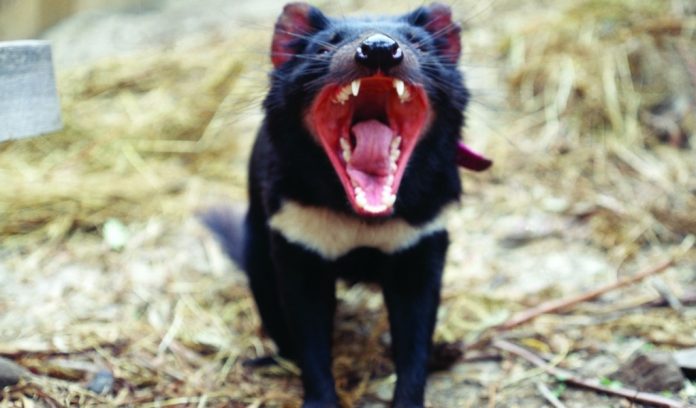
Few things in nature are as gruesome as devil facial tumor disease, the deadly cancer ravaging Tasmanian devil populations. The cancer first appears as clusters of lesions and lumps around the little marsupials’ mouths, but then it metastasizes until the creatures’ whole faces are covered in angry red welts. Eventually the tumors become so extensive that the animals can no longer eat, and they starve to death – unless they suffocate first.
Worse still, the disease is contagious. Unlike most cancers, which involve cells that betray their own hosts by multiplying at deadly rates, DFTD originated in a single individual and spread like a virus. In the 20 years since it was first discovered, DFTD has killed at least 80 percent of the wild Tasmanian devil population. The devils have no immunity; once infected, they are almost certain to die. The disease has defied treatment, and a 2007 study predicted it could drive the species to extinction within a few decades.
But at long last (and probably just in the nick of time) the devils are starting to put up a fight. In a study in the journal Nature Communications, scientists report that they’ve found new variants in parts of the Tasmanian devil genome associated with the immune system and cancer response – proof, these scientists believe, that the creatures are evolving resistance to the fast-moving disease.
Andrew Storfer, an evolutionary geneticist at Washington State University and a co-author on the study, had been following the sad case of the Tasmanian devils for years. He’d seen images of the creatures, which are the size of a pekingese and have the ferocity of a pit bull, covered in painful red tumors. He’d also read the studies predicting local extinction of some populations in a matter of years.
Strangely, some of those populations still persisted, despite the epidemiological models that predicted otherwise.
“At that point, our hypothesis was maybe there was evolution,” Storfer said. “The challenge, of course, was finding evidence in the genome.”
Luckily, scientists have been taking DNA samples of Tasmanian devils for decades – long before the current DFTD outbreak. Storfer and his colleagues were able to gather up the genomes of more than 250 individuals, quickly sequence relevant sections, and compare their samples to figure out where they differed.
Tasmanian devils have very little genetic diversity among them, because their population has been through several bottlenecks – periods when a sharp decline in population left just a small number of Tasmanian devils to spawn the next generation. This lack of diversity may have contributed to the weakness of their immune systems. If Tasmanian devils had evolved resistance to the cancer that ravages them, Storfer and his colleagues might find evidence of gene variants that didn’t exist before the outbreak.
They found exactly what they were looking for: two regions of the genome, both associated with immune function and cancer response, where devils from affected communities had variants that didn’t exist in the pre-outbreak population. Further study of the particular genes involved could help explain why DFTD is so deadly and how we might help animals without these gene variants resist the disease.
“We’re going to see if the favored alleles are actually conferring longer duration of survival” – i.e., keeping infected devils alive long enough to reproduce – “or more offspring. I don’t know necessarily they would provide complete resistance but they could be more related to resistance once infected,” Storfer said. “That’s going to help us understand how much damage individuals get, how fast that damage is, and how they survive.”
People often ask Storfer if he believes the devils will go extinct soon. He said no – “this result leads me to be optimistic.”
There’s something else that makes Storfer hopeful. Since the first contagious cancer was found in Tasmanian devils in 1996, another version emerged. Like the original DFTD, this cancer started with one cell from a single individual that was somehow able to infect thousands of others. When scientists sample the tumors on infected devils’ faces, they find the DNA of that original host, not the DNA of the devil whose face the tumor is on.
These kinds of transmissible cancer are rare in nature – they’ve been found only in dogs, Syrian hamsters, and a few species of shellfish – and the devils’ versions are particularly virulent.
“The fact that a second tumor evolved independently of the first, this seems very unlikely to happen by chance in just 20 years,” Storfer said. “That leads to speculation that this is part of the evolutionary history of the devil and maybe they’ve survived it before.”
If they’ve survived contagious cancer before, Storfer believes they can survive it again.
Picture: Quartz
—
(c) 2016, The Washington Post · Sarah Kaplan

